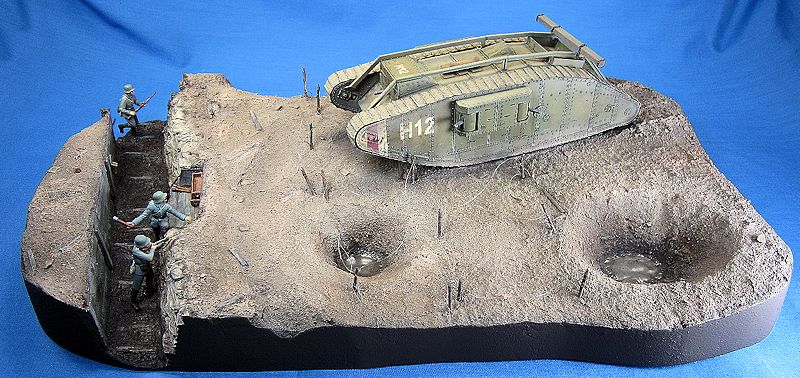
Emhar 1/35 British Tank Mk.IV 'Female'
| KIT #: | 4002 |
| PRICE: | $47.00 |
| DECALS: | One option |
| REVIEWER: | Scott Lyle |
| NOTES: |

| HISTORY |
The
Battle of Cambrai 1917
Over
the years several misconceptions have grown around the Battle of Cambrai.
It is often erroneously remembered as the first time tanks were used in
battle, or as the first tank-vs-tank battle, or other similar “firsts”
concerning tanks, most of which are not true. The “first” that the
battle does actually represent however is the first time a combined arms
force of tanks, artillery, infantry, and aircraft were used in concert to
execute a breakthrough on the battlefield. In that respect the battle
does represent the birth of modern armored warfare and the principles of
modern combined arms that would be used to shock the world again some
twenty-two years later in the hands of the rebuilt German Army.
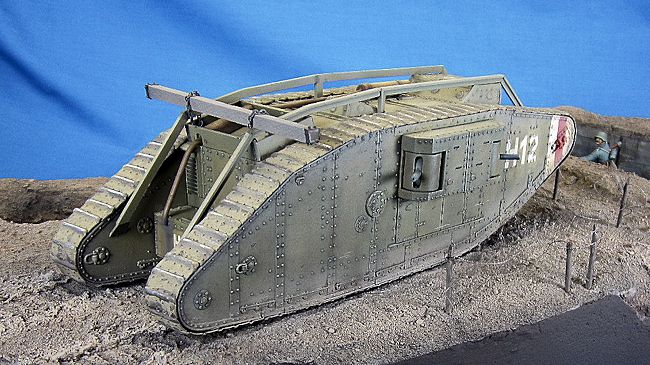 In November 1917 the European
powers were still locked in bloody, stagnant trench warfare.
The tremendous firepower of the machine gun had
literally forced armies underground early in the war, and major offensives
on both sides since that time had gained little ground for unsustainably
high casualty rates.
To break the deadlock of the trenches Great Britain
began developing “landships” in February 1915.
These machines, developed in secrecy, were long and
rhomboid-shaped to maximize their trench-crossing abilities.
The first production model, the Mark I, weighed 28
tons, was operated by a crew of 8, and could cross 8’ wide trenches.
In November 1917 the European
powers were still locked in bloody, stagnant trench warfare.
The tremendous firepower of the machine gun had
literally forced armies underground early in the war, and major offensives
on both sides since that time had gained little ground for unsustainably
high casualty rates.
To break the deadlock of the trenches Great Britain
began developing “landships” in February 1915.
These machines, developed in secrecy, were long and
rhomboid-shaped to maximize their trench-crossing abilities.
The first production model, the Mark I, weighed 28
tons, was operated by a crew of 8, and could cross 8’ wide trenches.
Great Britain first fielded
their Mark I tanks in September 1916 during the Battle of Flers-Courcelette,
but they were portioned out in small “penny packets” to support the infantry
and on the soft, muddy, shell-cratered ground of the battlefield many
quickly foundered and broke down.
Despite that loss of face the stalemate of the
trenches forced commanders to look for any way to break the impasse.
In July 1917 the British Army created an independent
Tank Corps, and its leaders, Colonel John Fuller and Brigadier-General Hugh
Elles, quickly began formulating their own tank doctrine.
They agreed that if tanks were concentrated in
sufficient numbers on firm ground and coordinated with infantry and air
units, they could spearhead an assault through the German trenches and into
the territory beyond.
With British industry making
tanks at a rapid rate, Fuller and Elles began searching for a suitable place
to launch their plan.
They quickly settled on the Cambrai area, but were
vetoed by the Army Chief of General Staff.
The commander of the Third Army, Sir Julian Byng,
picked up on it however and began lobbying for in their favor.
The Flanders campaign then underway distracted
everyone’s attention, but by October it was clear that the small gains made
in that campaign were not worth the cost and times were growing desperate.
British high command wanted to attack the Germans
again somewhere to sustain the pressure, but the French Army needed time to
rebuild itself.
The time was right for a few officers to test
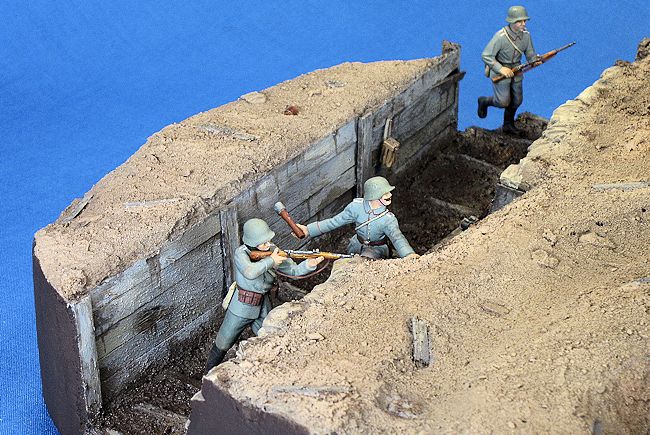 out
their “crazy” theories in a quiet sector of the front.
out
their “crazy” theories in a quiet sector of the front.
With the newly formed Tank
Corps under the command of Byng’s Third Army, planning began in earnest in
October 1917.
Basically the tanks were to set out for the German
trenches and crush the tangled belts of barbed wire before them, paving a
path for the infantry on foot behind them.
Once they reached the enemy trenches they would
cross them by dropping in fascines; large, primitive bundles of sticks
carried on top of the tanks that could be dropped into the trenches and
rolled across like makeshift bridges.
Fighters overhead would strafe the trenches,
covering the tanks and infantry below.
Preparations for the attack
were difficult; nearly 500 tanks, hundreds of new artillery pieces, hundreds
of thousands of shells and some 10,000 horses had to be stockpiled in a
narrow area, all while maintaining absolute secrecy!
Regular bombardments were carried out to maintain
the illusion of the status quo.
Finally at 2 am on November 20th
the tanks were fired up and driven out of their hiding places.
At 3 am the men were issued tea and rum, and at 6:10
am on the morning of November 20th,
the tanks started towards the German lines.
Initially the plan worked
perfectly.
The first belts of German barbed wire were crushed under the
tracks of the tanks, allowing the trailing infantry to walk through.
In most places the first line of German trenches
were easily overwhelmed.
Surprised German soldiers crept out of their dugouts
to see mechanical monsters lumbering towards them in the morning mist.
III Corps did extremely well, reaching its first
day’s objectives in less than five hours.
Enemy defenses that would have exacted horrible
casualties were overrun or surrendered.
By mid-day the German lines had a huge hole punched
in them, and the entire Gruppe in the area had been virtually either wiped
out or taken prisoner.
At the end of the 20th,
British forces rested some three to four miles deep into German territory
across a six mile front.
In Britain, church bells rang
out as the press trumpeted a great victory.
In actuality however the triumph was short-lived.
Literally half of the tanks that started out on that
day were lost, many to the enemy but most to mechanical breakdown.
The British were not prepared to exploit the
battlefield beyond the trenches.
Artillery could barely keep up with the tanks and
cavalry, nor could precious supply units.
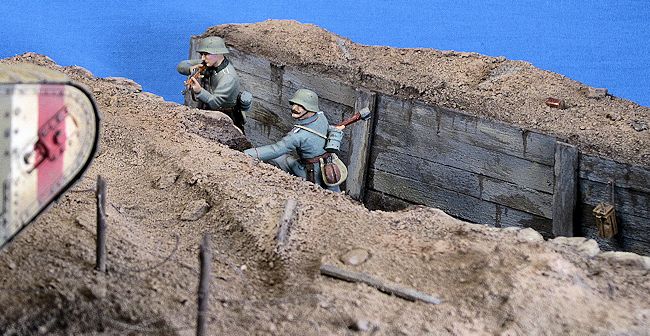 The 21st
saw the British push further and make more gains, but the Germans stiffened
and the going got tougher.
On the 22nd
the few operational tanks left were doled out in small groups, but by now
the Germans had devised tactics to defeat them.
What had started as a combined arms blitzkrieg had
devolved into an infantry and cavalry effort.
To stem the bleeding the German High Command had
brought in all of its reserves, and with many of the British troops
exhausted and running low on supplies, the tide began to turn.
The British got as far as Fontaine, but inevitably
had to pull back.
A huge German counterattack was launched on December
1st, but it too ran out of
steam and by the 7th the lines
had consolidated with the British only a couple of miles closer to Berlin –
this achieved at the cost of approximately 45,000 casualties per side.
The 21st
saw the British push further and make more gains, but the Germans stiffened
and the going got tougher.
On the 22nd
the few operational tanks left were doled out in small groups, but by now
the Germans had devised tactics to defeat them.
What had started as a combined arms blitzkrieg had
devolved into an infantry and cavalry effort.
To stem the bleeding the German High Command had
brought in all of its reserves, and with many of the British troops
exhausted and running low on supplies, the tide began to turn.
The British got as far as Fontaine, but inevitably
had to pull back.
A huge German counterattack was launched on December
1st, but it too ran out of
steam and by the 7th the lines
had consolidated with the British only a couple of miles closer to Berlin –
this achieved at the cost of approximately 45,000 casualties per side.
While strategically Cambrai ended as a minor, pyrrhic British victory, it was the battle that gave birth to modern armored warfare. Those with any imagination at all could see the day when armored vehicles would restore mobility to armies that had been forced underground by the machine gun. The Mark IV tanks at Cambrai were clumsy, unreliable, and slow, but they were the forerunners of what was to come.
| THE KIT |
Back in the summer of 2000 I got to go to England,
and one of the highlights of my trip was the Bovington Tank Museum, located
about 2 ½ hours southwest of London.
A massive museum with just about every
 armored vehicle
you can think of, the first exhibit I remember was a life-size reconstruction of
a harrowing World War I trench system that you walk through.
Towards the end of the exhibit you look up over the edge
of the trench to see – a huge British tank bearing down on you.
It made a big impression on me, and when I got home I
started building a World War I diorama depicting an Emhar British Mark IV Female
tank attacking a German trench.
With only a couple of figures (one who was originally
lying down in the trench as if wounded – an effect I didn’t really pull off) and
a very bland paint job, I’ve often thought of freshening up the diorama by
adding some more details, more figures, and a livelier paint scheme.
armored vehicle
you can think of, the first exhibit I remember was a life-size reconstruction of
a harrowing World War I trench system that you walk through.
Towards the end of the exhibit you look up over the edge
of the trench to see – a huge British tank bearing down on you.
It made a big impression on me, and when I got home I
started building a World War I diorama depicting an Emhar British Mark IV Female
tank attacking a German trench.
With only a couple of figures (one who was originally
lying down in the trench as if wounded – an effect I didn’t really pull off) and
a very bland paint job, I’ve often thought of freshening up the diorama by
adding some more details, more figures, and a livelier paint scheme.
| CONSTRUCTION |
I
can’t offer a blow-by-blow account of building the Emhar Mark IV as I built
it over ten years ago, but I don’t remember any large issues save for one –
the quality of the plastic.
In my boxing there were large flaws in several of
the large hull pieces.
Basically the plastic was brittle and “flaked” off
in places, as if there were large air bubbles underneath.
I remember having to cut away the flakes, apply
putty to the affected areas, and sand them smooth.
Other than that the kit went together well.
The level of detail is a bit soft by today’s
standards, and given that even the most obscure subjects are getting molded
these days it’s a bit surprising that no one has come out with a new kit of
what was essentially the world’s first main battle tank.
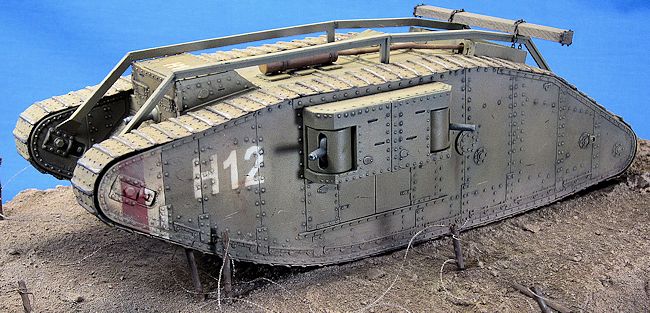 The diorama base was constructed
out of a piece of foam insulation, into which I cut the various contours using a
small saw.
To create the trench I originally used two sections of resin
sandbag wall by Model Cellar for the “front” wall and some balsa wood “planks”
for the “back” wall.
I also originally used a Model Cellar figure and a
Warriors figure to man the trench and some Eduard photo etch barb wire and tooth
picks to create the barb wire belts.
Some Woodland Scenics “Realistic Water” was poured into
the two craters and the tank was glued into place, pressed into twin tracks I
had carved into the groundwork.
The diorama base was constructed
out of a piece of foam insulation, into which I cut the various contours using a
small saw.
To create the trench I originally used two sections of resin
sandbag wall by Model Cellar for the “front” wall and some balsa wood “planks”
for the “back” wall.
I also originally used a Model Cellar figure and a
Warriors figure to man the trench and some Eduard photo etch barb wire and tooth
picks to create the barb wire belts.
Some Woodland Scenics “Realistic Water” was poured into
the two craters and the tank was glued into place, pressed into twin tracks I
had carved into the groundwork.
Sizing up the old diorama, I
decided against any major surgery.
I decided to leave the tank in place and work around it.
The trench, shell craters, and barb wire belts would
also remain in place.
Instead I would spruce up the trench by adding some new
details and new figures, then repaint everything except the tank.
I began in the trench by adding
new bits of wood framing to the “wood” wall and wood planks on the trench floor.
I applied MIG Productions “Mud” on the trench floor to
blend the new planks into the existing groundwork.
With these relatively simple additions in place I moved
on to the painting phase.
| COLORS & MARKINGS |
Back when I built the diorama I originally painted all of the groundwork - earth, sandbags, and wooden planks - one color of medium brown, spread some dark wash around, did a little dry-brushing, and called it a day. The result was a very monotone, boring-looking base – a sea of brown.
To spruce things I
first airbrushed some Testors Panzer Schokoladenbraun, a very dark brown, into
the
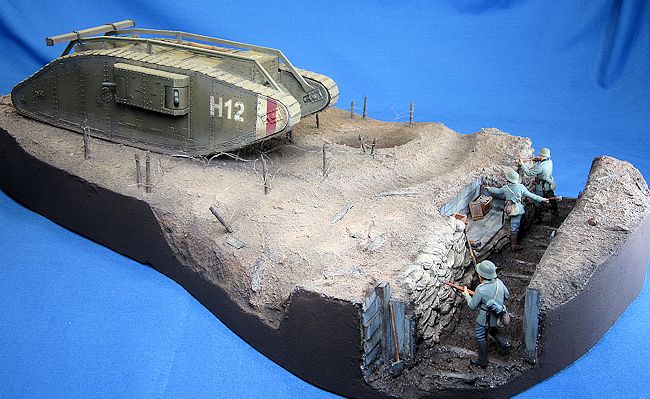 bottoms of the craters and the trench.
I next sprayed Testors Military Brown subtly into the
craters to add some clay-like variation, and then airbrushed a homemade mix of
Testors medium brown over the rest of the base, keeping it thin to let the
different shades show through.
bottoms of the craters and the trench.
I next sprayed Testors Military Brown subtly into the
craters to add some clay-like variation, and then airbrushed a homemade mix of
Testors medium brown over the rest of the base, keeping it thin to let the
different shades show through.
| FINAL CONSTRUCTION |
 With
the tank already in place, the first step in completing the diorama was to glue
the figures in place using Walthers Goo.
I then added some wooden crates and stick grenades to
the trench that I sourced from the spares box.
I mixed a little bit of dark wash and MIG Pigments
together to make a custom mud mixture and applied it to the figures’ boots to
make them appear muddier.
Some more pigments were used on the soldiers’ elbows,
knees, and gear to a bit more grime.
The final step was to paint the edges of the diorama
dark brown with acrylic craft paint, and with that, the diorama was done.
With
the tank already in place, the first step in completing the diorama was to glue
the figures in place using Walthers Goo.
I then added some wooden crates and stick grenades to
the trench that I sourced from the spares box.
I mixed a little bit of dark wash and MIG Pigments
together to make a custom mud mixture and applied it to the figures’ boots to
make them appear muddier.
Some more pigments were used on the soldiers’ elbows,
knees, and gear to a bit more grime.
The final step was to paint the edges of the diorama
dark brown with acrylic craft paint, and with that, the diorama was done.
| CONCLUSIONS |
I
enjoyed bringing some more life and creativity to this old diorama.
A new paint job helped spruce it up a bit.
With a couple more old dioramas on the shelf, I look
forward to “renovating” some more down the road.
| REFERENCES |
-
Osprey Publications, Campaign #187, “Cambrai
1917”
-
Osprey Publications, New Vanguard #133,
“British Mark IV Tank”
- Wikipedia, the Online Encyclopedia